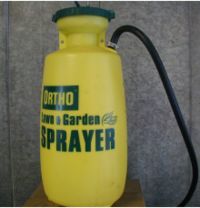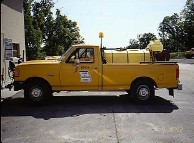821.10 Equipment and Application Methods: Difference between revisions
m Clarification, per Maintenance |
m Per MT, a minor clarification |
||
| Line 17: | Line 17: | ||
'''C. High volume/high pressure sprayers (truck mount or trailer type).''' Generally used in applications of herbicides to chemically trim or control trees and brush. High pressure is used to provide proper coverage to tree foliage and branches from considerable distances. Remember, high pressure creates more drift. | '''C. High volume/high pressure sprayers (truck mount or trailer type).''' Generally used in applications of herbicides to chemically trim or control trees and brush. High pressure is used to provide proper coverage to tree foliage and branches from considerable distances. Remember, high pressure creates more drift. | ||
'''D. Injector sprayers.''' Sprayers that use computerized injection systems. These sprayers give the operator the option of selecting, as needed, from several on board herbicides at the flip of a switch. Herbicides and water are mixed at the sprayer head eliminating the need for premixing. | '''D. Injector sprayers.''' Sprayers that use computerized injection systems. These sprayers give the operator the option of selecting, as needed, from several on-board herbicides at the flip of a switch. Herbicides and water are mixed at the sprayer head eliminating the need for premixing. | ||
The computer maintains output rates, automatically adjusting as different spray widths are selected or ground speed changes. Injection sprayers offer greater flexibility in herbicide application. | The computer maintains output rates, automatically adjusting as different spray widths are selected or ground speed changes. Injection sprayers offer greater flexibility in herbicide application. | ||
Revision as of 12:50, 8 April 2015

Definition: Equipment used for proper application of herbicides. Depending on the target species, several different application methods and equipment can be used. The proper equipment and application method(s) must be selected to ensure the proper results.
Methods:
A. Handheld and backpack sprayers. Normally used for spot treatments on small areas such as around buildings, fences and sidewalk edges. Also used for spot spraying of noxious and invasive vegetation.
B. Low volume/low pressure sprayers (truck- or tractor-mounted). Generally these types of sprayers are used in a low pressure broadcast application in which the operator applies the herbicide over a broad target area covering a large number of species or targets with one pass.
- Boom type - used for spraying shoulders and right of way.
- Boomless type - sprayers equipped with offset nozzles that apply herbicides in various swath widths.
- Most applications will involve a carrier rate of 30 to 40 gallons per acre application rate in broadcast applications.
C. High volume/high pressure sprayers (truck mount or trailer type). Generally used in applications of herbicides to chemically trim or control trees and brush. High pressure is used to provide proper coverage to tree foliage and branches from considerable distances. Remember, high pressure creates more drift.
D. Injector sprayers. Sprayers that use computerized injection systems. These sprayers give the operator the option of selecting, as needed, from several on-board herbicides at the flip of a switch. Herbicides and water are mixed at the sprayer head eliminating the need for premixing.
The computer maintains output rates, automatically adjusting as different spray widths are selected or ground speed changes. Injection sprayers offer greater flexibility in herbicide application.
 |
 |
 |
Special Recommendations:
A. Read the Label
B. Additional items need to be carried with the spray operator. These include but are not limited to:
- 1. Spill kit
- 2. MSDS and Labels
- 3. Spray reports
- 4. PPE
- 5. Clean water
- 6. Spare parts for repairs
- 7. Emergency telephone numbers
C. All equipment shall not be operated on slopes greater than 1V:3H (3:1).